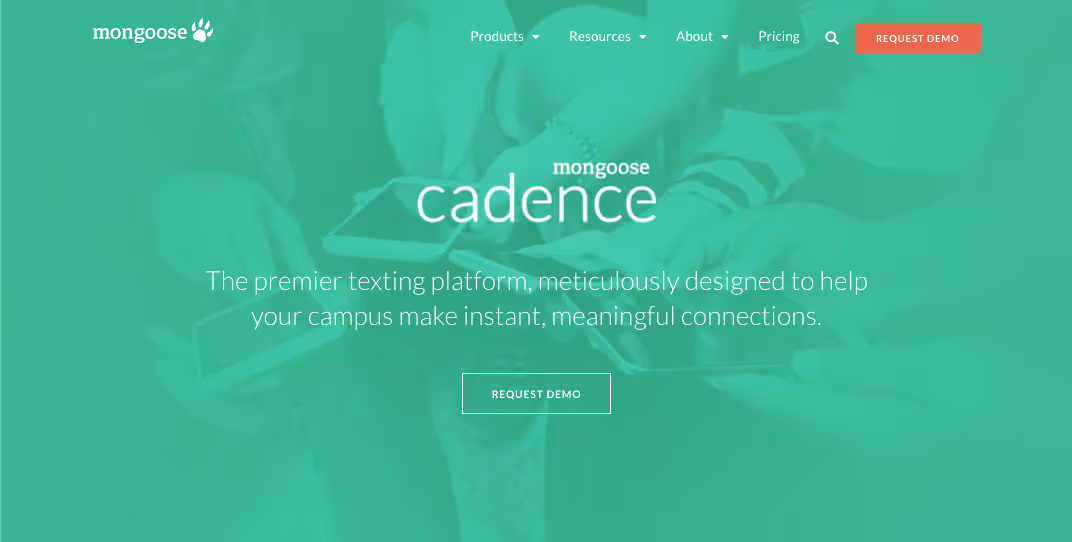About the Blog
What’s so great about this piece of edtech and why do over 600 higher ed institutions use it? Before we dive into all things Cadence, let’s make sure we’re speaking the same language. Then, hop on over to our Enrollify Exclusives feature of Cadence for a series of video interviews with Jeffrey Meece, Vice President of Strategy at Mongoose.
What is a texting platform?
You know how you use your personal phone to text your friends and family on the daily? Your messages are instantly sent and received, but it’s a pretty manual process when you think about it. Now imagine being an admissions counselor and needing to text your list of 250+ prospective students about an upcoming deadline because you know they’re more inclined to read a text than an email. Are you going to use your personal phone to do that? And are you going to take the time to send each contact a message 1:1, since sending a group message would violate privacy standards set by your school?
Contact management and scalability are two major ways that texting ‘platforms’ come in to save the day. A texting platform, from the higher ed vantage point, is a software that institutions implement to streamline and manage communications sent via SMS/text messaging to their constituents (students, parents, alumni, donors, staff, etc.). Whether someone from the admissions office is sending Susie a welcome text - or another staff member from the financial aid department is sending her an invitation to a FAFSA review, texting platforms allow all texts to be logged and organized by contact - so you know exactly what each student receives and when throughout the entire student lifecycle.
See how an actual texting platform (Cadence) works here.
3 competitive advantages of Cadence
1. Cadence is like the “OG” of higher ed texting platforms.
Granted, we all know just because someone was the first to do it, it doesn’t mean others can’t catch up over time. But...Cadence is still ahead of the curve. The engineering and product teams at Mongoose are constantly adjusting their roadmaps to anticipate market demands and the majority of their product and feature updates are based on actual customer feedback. Their “client love” mantra is serving them well as they’ve grown from a handful of early adopters back in 2014 to nearly 600 client institutions currently using Cadence.
2. It plays well with others.
We’ve said it before and we’ll say it again: technology that seamlessly integrates into the broader ecosystem is favored over the clunkier, harder-to-connect options. And Cadence comes packed with multiple native integration options depending on your existing CRM/SIS makeup as well as API, FTP, and manual/file-based integrations.
3. High speed sending is available, among other key features.
Nowadays, cell phone carriers like Verizon and Sprint can play a significant part in the efficacy of texting campaigns because of their ability to mark messages as spam and/or slow down the delivery speed - especially for mass texts. Cadence recently released a new feature that allows schools to send large quantities (thousands) of messages faster than ever before — almost instantly — with a much less risk of triggering carrier violations: High Speed Sending. You can’t currently find this with other platforms.
More about Mongoose
Mongoose is dedicated to being a bridge for higher education between schools and constituents. With a focus on conversational marketing software, Mongoose takes great pride in offering both the knowledge and the tools to help higher ed grow and retain a long-lasting collegiate community.
Both Cadence, their premier texting platform, and Harmony, their intelligent chatbot solution, exist to create successful outcomes for students and staff alike.
Find out more about Cadence's features through our series of videos with Jeffrey Meece, Vice President of Strategy at Mongoose 👇

CRMprov is a biweekly show that reveals how institutions can experience growth through technology. Tune in as higher ed enthusiasts Mickey Baines and Jamie Gleason partake in free-range dialogue around changes in edtech (including CRMs), vendor tutorials, insights on outcomes, industry adoption, and more!
{{cta('5def72e5-dcb5-4375-bb03-f8442485063a')}}










